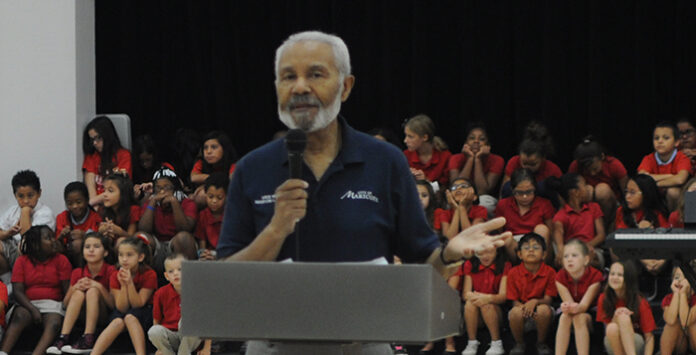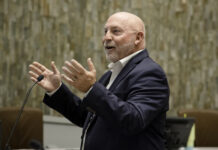
Maricopa City Councilman Marvin L. Brown is deeply devoted to his city, but he also sees the looming crisis on the horizon for the state.
Brown has spent the past decade on the city council and is one of the most informed people on the subject of water and sustainability in Arizona. He serves on the Pinal County Water Augmentation Authority, which has a presence and provided input into state and regional water issues. Representatives from cities in Pinal County sit on the board.
“We don’t have any immediate concerns with water consumption,” Brown said. “Even with Global Water’s very sophisticated process of cleansing, I give Arizona 30 years, if that long. I don’t even think it will be that long. Lake Mead seriously is distressed. We are not getting the snowfall that we’re used to getting. We’re not getting the rain. I don’t think I’m being pessimistic, I am being realistic.”
Also in the series Drought & Development
Overview
GWR touts strong water future for Maricopa
O’Halleran: Drought means no shortage of water issues
Contingency plan bites into Pinal County agriculture
Brown said he doesn’t see any way out of insufferable drought and heat for the entire Southwest in the next 30 years. He believes summer temperatures could hit 135 degrees by 2040.
According to many climatologists, Arizona is in the worst drought in more than 1,000 years, based on tree-ring studies. Brown said the state is already into a severe water crisis.
“2026 is the drop-dead or dead-pool year. They have no idea what’s going to happen – the Bureau of Reclamation, the governors of these states – what’s going to happen in terms of water by 2026?” he said adding that will be the years that will dictate the fate of the nation’s southwest states.
“Climate change is real. The drought will, more than likely, continue. Since I’ve been here, the summers have been longer and hotter,” he said.
Monday, the PCWAA heard about the impact of drought and the need for the Drought Contingency Plan from the Arizona Department of Water Resources, Central Arizona Water Conservation District and Maricopa-Stanfield Irrigation & Drainage District.
Brown described a grim future for the planet with the increased melting of the ice caps and rising oceans worldwide. The global warming means even worse drought conditions and unbearable heat for Arizona, according to the councilman.
“You cannot seriously welcome more growth when you’re in a state that is already in a desert. Nevada, California, Arizona – the Southwest, invites heat. More growth is building over land that could absorb water when and if it rains. It is bound to happen,” he said.
When asked if Maricopa is sustainable as a city, Brown said, “If I were living back east, I love Maricopa but to answer your question, I would not recommend anyone seriously thinking about it. If you thought about a young family, you might want to, in 20 years, relocate. I think it is going to be stifling here. In about 20 years from now, unless God really intervenes big time, it is going to be stifling in the Southwest – 135 and 140 degree temperatures in the summertime.”
Brown said he is not a negative person at all.
“If I see something that invites intervention, I think you should intervene. I’m not going to let it fester,” he said.
Brown left Michigan to come to Arizona in June of 2006.
“I knew I was going to a desert,” Brown said. “At the first meeting I went to when I got to Maricopa, before I ran for council, one of the major players in town at the time showed a chart of the growth that they planned. He was talking about how in 20 years the population of Arizona would be between 20 and 30 million from Phoenix, Maricopa County to Tucson in Pima County. He said that the growth in Maricopa should be 500,000 to 600,000. That didn’t seem to make sense to me. I asked, ‘Isn’t there a water consideration?’ at the time or even now? They said, ‘No, no we don’t have to worry about water.’”
After being elected to the city council in 2008, he became aware of the importance of water in the state of Arizona. Brown said Colorado, Wyoming, Utah and New Mexico get their water from Lake Powell while California and Arizona get water from Lake Mead.
“It dawned on me that all these millions of people were already drawing water from those sources. With continued growth, at some point it will be a problem. That problem is now,” Brown said.
At a recent state water meeting, Brown said a “high-level” Republican leader said, “maybe we should consider limiting our population growth.” He did not name the politician, only saying that the leader would not admit it in public.
“The developers don’t even want to hear that,” he said. “They want to build. At some point we need to be realistic in terms of where you are and what is doable. I say, as a citizen, that we should be more prudent in terms of our ongoing love to build. There is no way that Maricopa will be 600,000. If we hit 150,000 we should be happy.”
The problem lies in the belief that adding population equals progress. He said if Maricopa is 600,000, then Chandler would be 1.5 million and Gilbert would grow to 1.5 million.
“Because it is all a competition,” he said.
City of Maricopa planners project the city will be 161,000 people by 2050. Brown said, “that is doable.” He added some people are actually throwing around the idea of 300,000, which Brown said is not sustainable.
“With more population, you reach a certain threshold,” he said.
Brown said it is likely, with the coming cuts in water allotted to agriculture, farmers will likely start pumping water from the aquifer. Maricopa relies on that same aquifer for its drinking water.
“There is just so much that you can pump. You can put too many straws in the milkshake,” he said.
It is difficult for any politician, even a city councilman, to attempt to curb population growth, expansion and progress even if there isn’t enough water to support it.
“You’d catch hell from the Chamber of Commerce and your colleagues. No one wants to hear that – especially developers. Who wouldn’t want to come to a place where there’s sunshine 300 days a year? I was sold on it,” he said adding at 84, he’s probably not going to run for re-election again.
What do you think? Is Arizona really in water trouble? Share your opinion in the comments below.

![3 things to know about the new city budget Vice Mayor Amber Liermann and Councilmember Eric Goettl review parts of the city's 2024 operational budget with Mayor Nancy Smith on April 24, 2024. [Monica D. Spencer]](https://www.inmaricopa.com/wp-content/uploads/2024/04/spencer-042424-preliminary-budget-meeting-web-218x150.jpg)




![Elena Trails releases home renderings An image of one of 56 elevation renderings submitted to Maricopa's planning department for the Elena Trails subdivison. The developer plans to construct 14 different floor plans, with four elevation styles per plan. [City of Maricopa]](https://www.inmaricopa.com/wp-content/uploads/2024/04/city-041724-elena-trails-rendering-218x150.jpg)
![Affordable apartments planned near ‘Restaurant Row’ A blue square highlights the area of the proposed affordable housing development and "Restaurant Row" sitting south of city hall and the Maricopa Police Department. Preliminary architectural drawings were not yet available. [City of Maricopa]](https://www.inmaricopa.com/wp-content/uploads/2024/04/041724-affordable-housing-project-restaurant-row-218x150.jpg)

![City looks to lower property taxes again City Manager Ben Bitter speaks during a Chamber of Commerce event at Global Water Resources on April 11, 2024. Bitter discussed the current state of economic development in Maricopa, as well as hinting at lowering property tax rates again. [Monica D. Spencer]](https://www.inmaricopa.com/wp-content/uploads/2024/04/spencer-041124-ben-bitter-chamber-property-taxes-web-218x150.jpg)


![Alleged car thief released without charges Phoenix police stop a stolen vehicle on April 20, 2024. [Facebook]](https://www.inmaricopa.com/wp-content/uploads/2024/04/IMG_5040-218x150.jpg)

![3 things to know about the new city budget Vice Mayor Amber Liermann and Councilmember Eric Goettl review parts of the city's 2024 operational budget with Mayor Nancy Smith on April 24, 2024. [Monica D. Spencer]](https://www.inmaricopa.com/wp-content/uploads/2024/04/spencer-042424-preliminary-budget-meeting-web-100x70.jpg)


